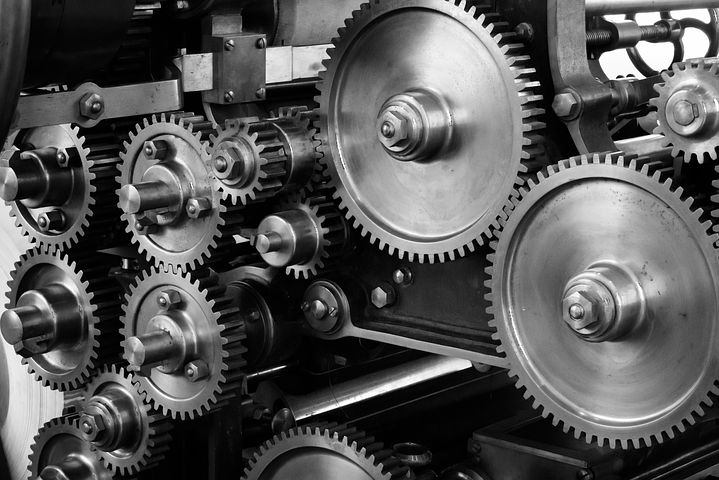This article was inspired by a paper written by Joel Bialosky et al in 2017. It is titled: Unravelling the mechanisms of MT: Modelling an Approach. A PDF of this article can be found for free online here.
The definition of mechanism:
“a system of parts working together in a machine; a piece of machinery”
When one thinks of the human body and its complexity, thinking of it as a piece of machinery is unhelpful. If we look at the cogs and gears in the picture I have included in this blog then this can infer that a specific application of force or movement in one piece of the machine will have a direct and measurable effect in another area. This method of thinking about massage, manual or physical therapies is the dominant narrative we encounter with patients, clinicians and society. It represents how most of us in the MSK professions were educated. Unfortunately, this mechanical narrative is still being perpetuated within our respective professions, and it is incorrect!
A specifically applied mechanical force on one part of the body, whether that is massage or joint mobilisations does not have a clinically meaningful measurable effect on the tissue it is applied to or to adjacent structures. Why? Because the human body is not a machine. It is not like a car or household appliance. It is a complex biological organism. Every person is different, and every person will respond differently to manual therapy interventions. I think there is a good argument to make that this overly mechanical comprehension of the human body is not serving the best interests of our patients. There is further commentary on this by Peter O’Sullivan in his 2012 article, It’s time for change with the management of non-specific chronic low back pain, here.
Eric’s bias
I have read most of the papers by these authors. That is a bias I should acknowledge. I really like their honest assessment of the literature and the research they do is important to our understanding of manual therapy and how it exerts its effects. I should state that this paper, like many other manual therapy papers, is mostly discussing joint manipulation rather than massage. The researchers are PTs and thus probably do very little massage. Although there might be some subtle differences in the exact mechanisms involved, I still think that when we are trying to understand how massage exerts its effects, the explanations from this body of research are still the least wrong. FYI, the effects of manual therapy are neurophysiological.
My highlights …
One of the first statements from this paper, “the biological effects of a treatment should be established.” This is followed up with, “We believe that research focusing on individual mechanisms in isolation will always fall short of providing meaningful insight.” I love this because it is so logical. If we don’t understand the mechanisms of how something works then we should stop making things up. This is all too common in the MSK world. Clinicians learn about anatomy but a proper understanding of physiology is often not fully appreciated. This results in non-scientific ideas where a therapist believes they can directly change a specific tissue with their hands or a special tool and then this is further extrapolated to mean that this is important to improve pain and/or function. If the biological plausibility is not established within the literature, making claims about how a treatment works is not helpful, and in most cases, incorrect. This does not necessarily change how you provide your treatment interventions, but the narrative on how things work and the mechanisms of effect need to be updated.
Their model was designed to account for the interacting mechanisms behind a complex MT intervention. It was designed to account for the mechanisms of MT on pain inhibition. It is worth mentioning that the neurophysiological effects are not limited to just what happens under our touch. Interventions are, “multifaceted and comprise specific and nonspecific factors related to the intervention, the patient, the provider, and the environment in which the intervention is provided … The mechanical stimulus from a MT intervention results in neurophysiological responses within the peripheral and central nervous systems responsible for pain inhibition.”
I respect the authors stating that they believe, “their model can be used for joint mobs, MASSAGE and neurodynamic interventions.” This covers all the various ways of pushing , pulling, twisting skin, joints and limbs. This is consistent with how I often present things in the courses I teach! Ha ha. Bias confirmed! 🙂 As far as we currently know, the mechanisms of effect are all the same. Each intervention is a different way of interacting with another person. Everybody is different. Everybody will respond to your intervention in a unique way. Why? Because humans are complex, the mechanisms of pain, manual therapy and MSK care are diverse and often unpredictable.
I want to emphasize that nothing the authors are talking about mentions anything about connective tissues. The research on either the ability to effect, or the need to change connective tissues in order to provide desired outcomes with manual interventions is not supported. I want to emphasize again. This statement is not to attack or diminish the good treatments that you the massage and/or manual therapist provides. What I want to emphasize is that the reasons for why people feel less pain, less stiff, more comfortable and confident in their movements or activities is predominantly from multiple factors including neurophysiological inputs. The model takes a nervous system approach to responses to MT in humans. The authors discuss how changes are correlated with the sympathetic nervous system, spinal cord–mediated responses, pain modulatory circuitry in the brain, endocrine responses, psychological impacts and neuromuscular responses to MT.
My journey
Initially, it was difficult for me to accept that my interventions didn’t work the way I thought. Discovering my education had little hard science behind it and realizing my thinking about how the body worked wasn’t supported by research was a tough pill to swallow. I spent a long time trying to validate my preferred comfortable narrative. It was neat, tidy and easy to apply with clear concise answers. My clinical reasoning was biomechanical, postural and myofascial. However, despite spending months/years reading a lot of biomechanical, orthopaedic and manual therapy literature, I couldn’t argue with reality. The body of literature was pretty clear. You can’t “change” connective tissues with your hands, and even more importantly you don’t need to in order for people to feel better. Posture and biomechanics is not consistently associated with or predictive of pain. Palpation is unreliable as an assessment tool. I felt like I was left with little to cling on to.
I had a successful full-time practice and I helped hundreds of new patients each year. It didn’t make sense that what I was doing didn’t work? At least that is what I initially thought. Once I realised that what I was doing still had huge value but the reasons for how things worked were different, this allowed me to embrace the current science and it actually gave me more options for care as I didn’t need to always focus on things that might not matter as much. I needed a new narrative to adopt. One that was evidence-based, positive and empowering to my patients. The better I got at understanding pain, the more time I spent listening to patients, experimenting and being curious to see what felt good and what didn’t, the better the clinician I became. I now had a better understanding for why some people were suffering so much, why others improved so quickly and better explanations for how and why.
Last thoughts
Studies like this one and countless others have really influenced my way of thinking, reasoning, and communicating with patients. It informs how I teach and how I engage with learners in my courses. This quote from the paper cannot be ignored, “Little has changed to support a mechanism related to the specific biomechanical parameters of the interventions, studies continue to refute a specific biomechanical mechanism, clinical examination process for determining biomechanical dysfunction continues to be unreliable, relates poorly to clinical outcomes, and demonstrates a poor association with reliable and accurate mechanical measures as well as with magnetic resonance imaging. We believe that this perpetuation of dated modes of action for MT is both unsubstantiated and counterproductive.”
Let’s not forget the power of expectations. The non-specific effects of a treatment are very powerful. They are likely more powerful and predictive of outcomes than anything else we do. If a patient has a positive treatment expectation, and the clinician also has a positive treatment expectation, this is shown to have a strong predictor for positive treatment outcomes. This goes the other way too. If a patient and provider have negative expectations, then the outcomes are likely to be less favourable. Prior research by these same authors has supported this statement. The mechanism of effect for non-specific effects? These are neurophysiological too. Psychological and social factors also exert effects on the person and can influence biology. Humans are complex and how or why someone responds to a treatment includes a lot more factors than simply attempting to change soft tissues with our hands.
How can we change things for the better?
A focus on knowledge translation is required en mass in order for change to occur and for best practices to be adopted by those who spend their days in the clinic helping those who seek our care and support. This is my goal. To bring the information to the masses and hopefully inspire others to take an interest in current research and understanding. I strongly believe that massage therapists can be leaders in the management of MSK concerns. Does this mean our current interventions are ineffective or unhelpful? Of course not. It means we need to understand the limitations to our interventions and appreciate there is a lot of complex neurophysiological mechanisms involved within every treatment encounter. Acknowledging uncertainty, adapting communication, and incorporating movement/exercise strategies that are informed by current research is necessary. The one thing I have found which is very humbling, is being comfortable without having all the answers and acknowledging the value in holding a safe and respectful space for those who come into our clinical environments. In my opinion, that is the sign of an evidence informed clinician 🙂
Thanks for reading.
~ Eric
Interested in learning more?
Join our virtual training community for the massage, manual and movement therapist. The MMTC provides ongoing webinars and training from clinicians, researchers, educators and thought leaders from around the world.
Click on the image below to see what is coming up in the MMTC.
https://ericpurves.lpages.co/mmtc-invite-a-friend






One Comment